Menus
- The 250cc world champion machine
- Haas and Rennmax rush from success to success
- In the saddle of the racing legend
- Unusual right shift
- Technical specifications
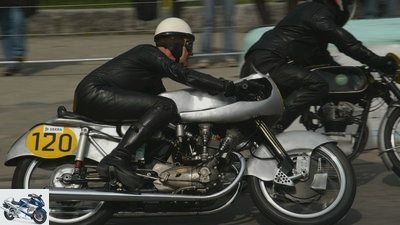
Noll
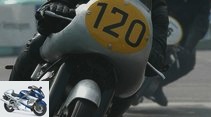
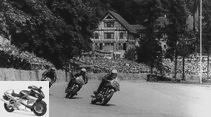
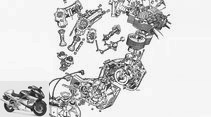
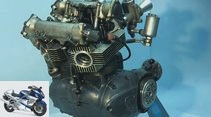
11 photos
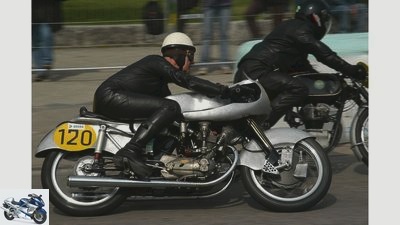
Noll
1/11
NSU Rennmax from 1953.
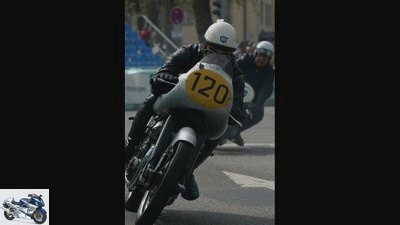
Noll
2/11
Accelerate out onto the straight line: Now it’s time to fold up behind the tiny pane as well as possible.

Noll
3/11
Fully occupied ranks at the international Solitude race in June 1953: Here Haas leads ahead of Daiker (102) and Wunsche on DKW (116).
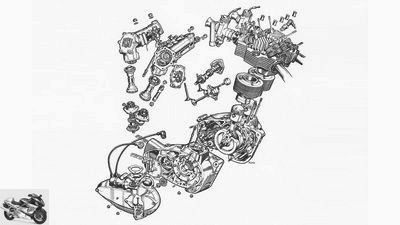
Noll
4/11
This exploded view shows the Rennmax engine from 1952, recognizable by the oil compartment at the front, the cooling fins on the housing and the front engine bracket that has been omitted from the 53 model.
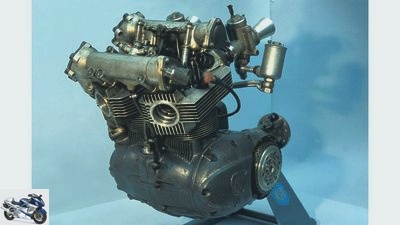
Noll
5/11
Thoroughbred racing engine: The parallel two-cylinder Rennmax had nothing in common with the series Max. Here the 1953 engine without an integrated oil tank.
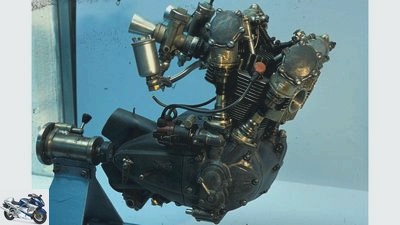
Noll
6/11
Thoroughbred racing engine: The parallel two-cylinder Rennmax had nothing in common with the series Max. Here the 1953 engine without an integrated oil tank.
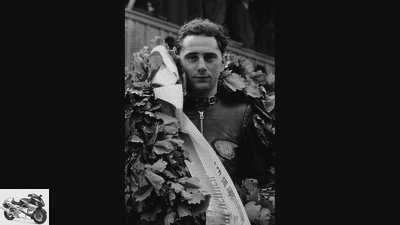
Noll
7/11
Familiar picture in the 1953 season: Werner Haas with a laurel wreath.
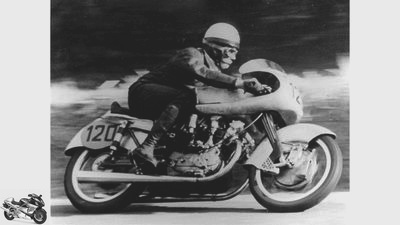
Noll
8/11
Successful duo: With two first and three second places Werner Haas became 250cc world champion on the NSU Rennmax in 1953.
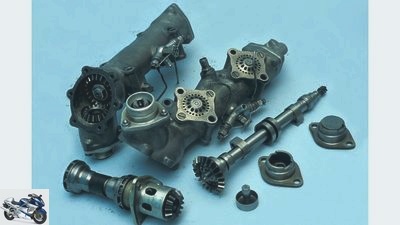
Noll
9/11
Elaborate solution: The camshaft housings were placed on the cylinder head. A construction similar to the supercharger racers at the end of the 1930s.
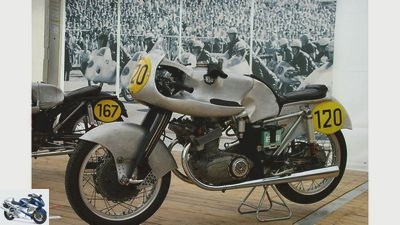
Noll
10/11
The 1953 Rennmax with a hand-made backbone frame made of chrome-molybdenum sheet metal and an oscillating fork.

Noll
11/11
Must be fun: Werner Haas after the victory at Hockenheim. Teammates Bill Lomas (back) and Otto Daiker are happy with him.
NSU Rennmax from 1953
The 250cc world champion machine
Content of
Sixty years ago, Werner Haas and his NSU Rennmax wrote history: The young man from Augsburg was the first German to win the motorcycle world championship title. Jurgen Noll had the opportunity to drive the legendary 250cc machine. And tells the story of this success, which actually seemed to end before it really began.
It started with a letter stating the contractual relationship between NSU and its factory drivers concluded: “Since it is currently not yet possible to predict how our racing machine program will finally be designed for next year and when the individual classes will be used, we are terminating the contract of March 1, 1951 as a precautionary measure … “It was said after the 1951 season. With similar wording, other companies had already announced their withdrawal from racing in the past. Was that the beginning of the end of the racing history of the Neckarsulm motorcycle manufacturer? Or just a diversionary maneuver with which one wanted to lull the competition into safety?
Buy complete article
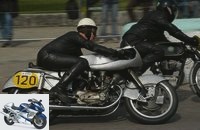
NSU Rennmax from 1953
The 250cc world champion machine
The first steps
Noll
The 1953 Rennmax with a hand-made backbone frame made of chrome-molybdenum sheet metal and an oscillating fork.
At that time, the production of the 200 Lux models had just started, a 250 four-stroke machine was still in the development stage. But the company’s management had decided to build a racing motorcycle for the quarter-liter class as well. While chief designer -Albert Roder and his right-hand man, the qualified engineer Ewald Praxl, were responsible for the development of the 125cc Rennfox, Dr. Walter Froede, head of the NSU racing department, was commissioned by the company bosses to implement the 250cc project. In contrast to the single-cylinder two-stroke series model, a 250 parallel two-cylinder four-stroke engine was planned for the “R22” racing version. In 1952, the new designs faced the competition for the first time at the international DMV Rhine Cup race in Hockenheim. They surprised with very good lap times, but retired due to connecting rod bearing defects. Anyone who expected a 250 with a pressed steel frame was disappointed.
Froede saw certain advantages in using a double-loop tubular frame with a telescopic fork. For reasons of sales policy, this did not seem very clever, after all, the company never missed an opportunity to point out the advantages of the pressed steel frames used in the series machines. The racing engine of the R 22 had two overhead camshafts, each driven by a vertical shaft. Bucket tappets, open hairpin valve springs, primary chain drive and battery ignition were further features of the approximately 28 hp engine, which was somewhat similar to the successful two-cylinder engines of the compressor era.
The two-cylinder NSU achieved its first victory on the Berlin Avus. The still relatively unknown Karl Hofmann drove a sovereign victory with an average of 148.23 km / h. On July 20, 1952, the first World Cup run in post-war Germany took place. With 150 drivers from 14 nations who started at the Soli-tude near Stuttgart. In front of the 400,000 (!) Enthusiastic spectators, NSU faced international competition for the first time after the end of the war. The Neckarsulm team competed with four 125s and three 250s. But Hofmann and Colombo crashed during training and NSU was suddenly missing two drivers. The factory provided the then little known licensed driver Werner Haas with a racing fox this weekend, whereupon the young Augsburg driver promptly thanked him with a victory. Haas drove the international competition to the ground. Neither the world championship leader Cecil Sandford on MV Agusta nor last year’s world champion Carlo Ubbiali on Mondial could keep up with the young talent. The reward: a work contract for 1952 and 1953 in both classes for Haas.
In the meantime, the NSU designers had come to the conclusion that Roders’ pressed steel frame in conjunction with the rocker arm had advantages over the tubular frame and telescopic fork favored by Froede. The engine tuners had increased the output of the 250 engine to a good 30 hp, and the primary drive was switched from chain to gear. And since the factory had just launched a sporty 250cc four-stroke machine with the name “Max”, the R 22 was called “Rennmax” from then on..
Noll
Successful duo: With two first and three second places Werner Haas became 250cc world champion on the NSU Rennmax in 1953.
At the Grand Prix of Nations in the royal park of Monza, the two racing masters piloted by Haas and Colombo surprised with starting positions in the front row. At the start, however, they only got going when the four red Guzzis were up and away. But Haas once again demonstrated his driving talent. In the second lap he caught up with the leading group – a hussar piece with which the Nobody in the GP circus drove straight into the hearts of the Italian spectators. Lorenzetti put enormous pressure on with his lighter Moto Guzzi, which Haas withstood with a new lap record (average of 153.76 km / h). Spectators and mechanics held their breath. But the newcomer from Augsburg was just as confident in his Rennmax as the old fox Lorenzetti was in his Gambalunghino. On the last lap Werner Haas had a lead of 30 meters when he switched on the last corner. Lorenzetti caught up again and won with a lead of 20 centimeters!
The Rennmax was revised over the winter of 1952/1953. They were essentially chassis modifications, instead of the heavy series frames and forks, similar-looking parts were made from thin-walled chrome-molybdenum sheet metal. The racing machines continued to lose weight through the increased use of aluminum. The entire stern was now made from it and had undergone aerodynamic improvements at the same time. Furthermore, the partially faired front wheel now had a huge brake with a drum diameter of 250 millimeters, and the entire machine looked much more elegant than the previous year’s model. Only the engine seemed unchanged, despite the newly developed crankcase with an oil distributor, a crankshaft with Hirth coupling, forged cylinder heads and further detail improvements.
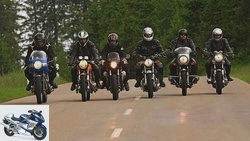
Tourer
On the move: classics of the 70s
Europe wheel
read more
Haas and Rennmax rush from success to success
Noll
Familiar picture in the 1953 season: Werner Haas with a laurel wreath.
The fact that the racing department had done a great job was already evident from the first outings in spring 1953: Bill Lomas won the first race of the year in Floreff, Belgium, while Werner Haas won in Hockenheim and team-mate Reichert took third place. The first world championship run that year took place on the Isle of Man, with a length of 60 kilometers the most difficult race track in the world. The TT-experienced Lomas had already familiarized Werner Haas with the dangers of the island course in a three-week training program in March of this year. That should pay off: Werner Haas was in the lead right from the start, but in the end only Fergus Anderson and his double-cam Guzzi had to admit defeat. Measurements on different sections of the track showed, however, that the Rennmax was the fastest machine in the field, with top speeds of over 190 km / h. Ultimately, Anderson’s better track knowledge was decisive for the race.
Anderson could not claim this advantage for himself at the following World Championship round in Assen, the Netherlands. Haas won here with a lead of 1.6 seconds. Irishman Armstrong drove his Rennmax to third place. This triumph was followed by a fantastic series of successes for the 53er Rennmax with another victory at the World Championship run in Schotten, second places at the Ulster GP and in Monza as well as triumphs in other races on the Solitude, Avus and Eilenriede. After only three years of development, NSU had made it to the top of the world. At the same time, 26-year-old Werner Haas became NSU’s star driver, immortalized in the history books as double world champion in 1953 in the 125 and 250 classes.
In the saddle of the racing legend
Noll
Accelerate out onto the straight line: Now it’s time to fold up behind the tiny pane as well as possible.
And I’m actually allowed to drive this 250cc Rennmax here, at the Donauring Revival in Ingolstadt! So set the ignition adjustment lever to “late”, pull out the ignition switch and flood the float chambers. The first gear of the gearbox to be shifted to the right is on top; it is latched into place with a light swipe of the boot tip. Pull the clutch, push it and let the lever come – after ten meters the first cylinder ignites and pulls the other with it. I bring the engine up to operating temperature with short bursts of throttle, during which the needle on the rev counter oscillates between 4000 and 8000 rpm. At the pre-start I join a group that is waiting for the route to be cleared. When this happens, we stroll in rows of two from the pre-start area, turn right onto an approximately 100-meter-long feeder road to the track, and finally turn left onto the start and finish straight.
Second gear. A wide road, about 300 meters long, the right lane of which is separated by pylons from the pit lane and the access to the start and finish straight. With my left hand I pull the motorcycle goggles from my old Roman helmet and press them firmly onto my nose. The ride can begin. A bunch of around 25 or 30 motorcycles quickly thread their way onto the straight and aim for the first left turn. The first round is to get to know each other and to warm up. – Some very impetuous pass me by, as if it were about space and victory. But first I have to get to know the machine, learn the gradation of the four-speed transmission, try out the brakes and get used to the handling. Just don’t get reckless, especially since there is oil at the start of the home straight, as a driver warned me from the previous run who crashed at this point.
A small distributor that Bosch had designed for NSU at the time, in conjunction with two small 6-volt batteries, makes the use of a heavy, exhausting magneto superfluous. The integrated flyweights have an adjustment range of 38 degrees. The pre-ignition can be turned a further twelve degrees using a hand lever on the left side of the handlebar. Now, on the straight, is the best time to do it. The twin acknowledges 50 degrees pre-ignition with significantly more thrust.
The pace is getting faster. Significantly faster. I choose the same braking point as on the previous lap. And notice that the braking distance is now significantly longer. I lift the gearshift lever briefly with the toe of my right boot, while the second one, the engine brakes enormously. Still, the straw bales are getting bigger and bigger, and I need all the space the curve offers.
Italian classics
Trio for Tifosi
read more
Unusual right shift
Noll
Fully occupied ranks at the international Solitude race in June 1953: Here Haas leads ahead of Daiker (102) and Wunsche on DKW (116).
The machine and the track now require my full attention. The piste leads in a wide curve to the right in a westerly direction, followed by a slight curve to the left, then a curve to the right and then a sharp left, in the outer area of which the sloping curbs of a traffic island are located. Around the corner, 30, 40 meters further down a short downhill section with a left-right combination, at the beginning of which a traffic light flashes. Behind it, it may be another 50 meters, it goes through a secluded archway of an old fortress wall. There is therefore an absolute no-overtaking rule between the traffic lights and the archway, and the passage is barely more than four meters wide. It gets really tight when you tilt. Shortly thereafter, there is a sharp bend to the left, which is crossed by a red bicycle path marking at the entrance to the curve and by a zebra crossing at the exit. Fortunately, the track is dry. On the following uphill stretch, I reach the first machines that overtook me on the warm-up lap. In the third pass, another one, back to the second, and then brake full can, keep to the far right, and off you go again on the start-finish straight, past the spot that has been strewn with binding agent. At 9000 tours I shift up to third with one kick down.
Yes, it takes some getting used to before all of this becomes flesh and blood. The day before yesterday I was on tour with my daughter’s Yamaha. With left-hand gearshift, but with the Rennmax everything is exactly the opposite, including the gearshift pattern. Full concentration is required. But it works better with both of us from lap to lap, and the long left turn between the wide arches becomes a really tight corner. For the first time, I’m in fourth, the highest gear of the 53 model, and the machine continues to accelerate. A good 30 hp with a weight of around 120 kilograms, 60 years ago that was enough for a top driver like Werner Haas to become world champion in the quarter liter class.
Now shut the tap, back into the third, apply the hand and foot brakes and shift down a gear. The rear wheel locks for a short time, rubber squeaks, the machine begins to wobble slightly, but without breaking out dangerously, even if it may look spectacular. At the entrance to the bend it has long since returned to a stable track. I have them carried far outwards, touch the sloping curbs of the traffic island, use them like a small neighbor in motocross. The chassis does it calmly and shows no nervousness. Not even when the person in front pulls in and inadvertently cuts off my route. I catch my breath. Put on the brakes, and do so in full lean angle! But nothing happens, the NSU sags slightly at the front, but stably follows the specified direction. The Conti tires mounted on light alloy high shoulder rims adhere better than their measly dimensions – 2.75 x 18 at the front, 3.00 x 18 at the rear – suggest.
At the end of the bend I pull up the two one-inch Amal racing carburettors again, after a few meters at the 10,000 mark, I shift down into third gear with a light step and make myself as small as possible at the start / finish, far behind placed buttocks and low upper body. The forearms rest relaxed on the side tank rests. Knee closure is mandatory, even or especially in the curves. With our chin pressed into the orange-colored foam padding, which is supposed to prevent the vibrations from being transmitted from the machine to the pilot’s head, we thunder down the straight, fixing the next braking point through the tiny disc of the perfectly crafted tank / fairing combination. Without this pillow, eyesight would be severely impaired, as I saw a lap earlier when the tip of my chin came too far to the edge of the pillow. Suddenly, instead of the route and the driver, I only saw an amorphous structure! But now everything fits, the Rennmax and I, we seem to be flying. However, the brakes should be more powerful at this pace. A thermal problem? The result of the many narrow corners? Well, maybe I’m too spoiled by the braking behavior of modern disc brakes.
Suddenly a man jumps to the edge of the road, kneeling and holding a box towards me. Washed over. Same game in the next round. But now I’m prepared for it. Look down past the small disk to the right. It shows me the position I’m lying in. First, I read +5 seconds. And have to laugh. Who is this man? I actually have no idea, nor do I know my placement. It’s not about anything. But I am pleased with the ingenuity and exuberance of the visibly enthusiastic viewers who come up with such ideas. Pit signs from the edge of the road – just like when NSU chief mechanic Horch and his men held the signs.
Noll
Must be fun: Werner Haas after the victory at Hockenheim. Teammates Bill Lomas (back) and Otto Daiker are happy with him.
It goes like this for another two or three laps, then the black and white checkered flag falls, which signals the end of this run far too early. I stand up, pull my motorcycle goggles off my face, and do the lap one last time. The spectators wave and applaud all participants. We wave back until the marshals show us the way to the paddock with their yellow flags. When I arrive in front of the Audi Tradition tent, I sit happily immersed in the machine for a while. Then I close the two somewhat stiff fuel taps, press the ignition switch in and answer the questions of the many curious visitors: No, the orange sponge on the tank is not for wiping off sweat, not even for cleaning my glasses. No, and I haven’t ridden this machine before. That was Werner Haas. I just have the same helmet and a similar looking racing suit. No, no, the machine is not mine. It is owned by Audi Tradition. What is it worth? Good question. Priceless.
“Oh, crap!” Shouts an Audi employee as I get off the machine. He points to the inside of my leather suit. The knee area, previously deep black, is now light silver. “From the aluminum of the tank. Hopefully it will work again. ”“ It doesn’t need to, ”I reply,“ it’s more precious to me than real silver. ”Because it will remind me of this trip forever – with the machine that made Werner Haas world champion.
Technical specifications
Noll
Thoroughbred racing engine: The parallel two-cylinder Rennmax had nothing in common with the series Max. Here the 1953 engine without an integrated oil tank.
Data R22-53
Engine:
Air-cooled parallel two-cylinder four-stroke engine, two overhead camshafts, each driven by a vertical shaft, two valves per cylinder, bore x stroke 54 x 54 mm, 248 cm³, compression 9.7: 1, approx. 31 hp at 10500 / min, two 25.4 millimeter Amal carburetor, multi-plate dry clutch, four-speed gearbox
Landing gear:
Backbone frame made of chrome-molybdenum sheets, pushed short swing arm at the front, two-arm swing arm with two spring struts at the rear, wire-spoke wheels, tires 2.75 x 18 at the front, 3.00 x 18 at the rear, simplex drum brake at the front, Ø 250 mm, simplex drum at the rear
Weight:
about 121 kg (without petrol)
Top speed:
about 191 to 199 km / h depending on the gear ratio
Related articles
-
Test: Norton 18 H racing machine
Noll Test: Norton 18 H Racing motorcycle from the 1920s Content of In the 1920s, the Norton 18 H was one of the most successful half-liter machines – and…
-
Urs Pedraitas Victory Grizzly circumnavigating the world
Rossen Gargolov 24 photos Rossen Gargolov 1/24 Test editor Thomas Schmieder drove Urs Pedraita’s round-the-world victory. Rossen Gargolov 2/24…
-
Ducati Panigale R and World Cup bike in comparison
Ducati 23 photos Ducati 1/23 The Ducati Panigale R – now without specifying the displacement in the name – and the works bike at the rendezvous. Ducati…
-
Gunbus 410 the largest drivable motorcycle in the world
Rossen Gargolov 17th photos Rossen Gargolov 1/17 Future young drivers of 2033. Rossen Gargolov 2/17 MOTORRAD colleague Thomas Schmieder trying to sit or…
-
Suter two-stroke racing machine MMX 500
2snap 14th photos Marco Zamponi 1/14 Picture gallery, sport: The Suter MMX 500 is to show on the Isle of Man that the two-stroke engines still have a…
-
Osterling 7th photos Osterling 1/7 BMW RS 54. Osterling 2/7 Narrow, short, light the RS 54 weighs only 132 kilograms. Osterling 3/7 Not original: Like…
-
Suzuki GSX-R 1000 R in the driving report
Suzuki 27 photos Suzuki 1/27 Suzuki GSX-R 1000 R. Suzuki 2/27 Suzuki GSX-R 1000 R. Suzuki 3/27 Suzuki GSX-R 1000 R Suzuki 4/27 Suzuki GSX-R 1000 R….
-
500cc Grand Prix machines Royal children The road world championship is celebrating its birthday: 50 years ago the first race started on the Isle of Man….
-
KTM 690 Duke put to the test – the cornering machine from KTM
20th photos 1/20 Such deposits are no problem for the single. 2/20 Also available in black – the KTM 690 Duke….
-
BMW K 100 Biturbo world record motorcycle
bilski-fotografie.de 21st photos bilski-fotografie.de 1/21 BMW K 100 Biturbo in the studio. bilski-fotografie.de 2/21 Unfortunately, it was never used -…